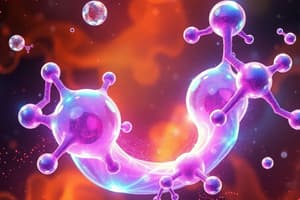Podcast
Questions and Answers
What is a salt?
What is a salt?
- Formed when an acid and a base react (correct)
- An element on the periodic table
- A type of metal
- A product of a combustion reaction
What happens during a neutralization reaction?
What happens during a neutralization reaction?
- Formation of only a salt
- Formation of a salt and water (correct)
- Formation of a gas
- Acid and base remain unchanged
Which of the following is a property of bases?
Which of the following is a property of bases?
- Neutralization of bases by acids
- Formation of hydroxide ions (OH⁻) (correct)
- Strong acidic nature
- Release of protons (H⁺)
What is the role of a strong base in a solution?
What is the role of a strong base in a solution?
How is a salt produced?
How is a salt produced?
What type of bases, like ammonia and carbonates, cannot completely neutralize acids?
What type of bases, like ammonia and carbonates, cannot completely neutralize acids?
Which type of acids like citric acid and acetic acid only partially dissociate in water?
Which type of acids like citric acid and acetic acid only partially dissociate in water?
What does a pH of 7 indicate on the pH scale?
What does a pH of 7 indicate on the pH scale?
Which substances generally have pH values close to the extremes on the pH scale?
Which substances generally have pH values close to the extremes on the pH scale?
Understanding the interactions between acids and bases is essential for comprehending the formation of:
Understanding the interactions between acids and bases is essential for comprehending the formation of:
Study Notes
Acid-Base Interactions and Salts
Acids and bases play a fundamental role in our everyday life and chemistry. Understanding their interactions helps us grasp the concept of salts and their properties. Let's dive into the world of acid-base systems, salts, and the pH scale.
Types of Salts
A salt is a product of an acid-base reaction, also known as a neutralization reaction. Salts are formed when an acid and a base react together, combining their positive (cations) and negative (anions) ions. Some common examples of salts are sodium chloride (NaCl), potassium nitrate (KNO₃), and calcium sulfate (CaSO₄). Salts are often formed in aqueous solutions and have no net charge, making them neutral to the environment.
Neutralization Reactions
Neutralization reactions occur when acids and bases react with each other, forming a salt and water. The reaction can be represented as:
Acid + Base → Salt + Water
For example, when hydrochloric acid (HCl) reacts with a base like sodium hydroxide (NaOH), sodium chloride (NaCl) and water (H₂O) are produced:
HCl + NaOH → NaCl + H₂O
The water formed during this reaction is a byproduct of the reaction and does not change the acidity or basicity of the solution.
Properties of Bases
Bases are substances that can accept protons (H⁺) and form hydroxide ions (OH⁻). Strong bases like sodium hydroxide (NaOH) and potassium hydroxide (KOH) dissolve in water and completely neutralize acids. Weak bases, such as ammonia (NH₃) and carbonates (CO₃²⁻), cannot completely neutralize acids because they only partially dissociate in water.
Properties of Acids
Acids are substances that can donate protons (H⁺). Strong acids like hydrochloric acid (HCl) and sulfuric acid (H₂SO₄) completely dissociate in water and release their protons. Weak acids, such as citric acid (C₆H₈O₇) and acetic acid (CH₃COOH), only partially dissociate in water.
The pH Scale
The pH scale is a measure of acidity and basicity, with a range from 0 to 14. A pH of 7 is considered neutral, indicating a solution that is neither acidic nor basic. Solutions with a pH lower than 7 are acidic, while solutions with a pH greater than 7 are basic. Strong acids and bases generally have a pH close to their extremes, while weak acids and bases have pH values closer to 7.
In summary, understanding the interactions between acids and bases is essential to comprehending the formation of salts. Neutralization reactions, the properties of acid and bases, and the pH scale are fundamental concepts when studying these interactions. By learning about these topics, you'll be able to explore a wide array of scientific applications that involve acid-base systems and salts.
Studying That Suits You
Use AI to generate personalized quizzes and flashcards to suit your learning preferences.
Description
Test your knowledge on acid-base systems, salts, and the pH scale with this quiz. Learn about different types of salts, neutralization reactions, properties of acids and bases, and how the pH scale measures acidity and basicity.




